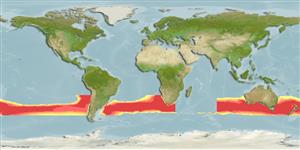>
Zeiformes (Dories) >
Oreosomatidae (Oreos) > Oreosomatinae
Etymology: Neocyttus: Greek, neos = new + Greek, kyttaros, kytos = a convex cavity.
Environment: milieu / climate zone / depth range / distribution range
Ecología
marino batipelágico; oceanodromo (Ref. 51243); rango de profundidad 200 - 1240 m (Ref. 6390), usually 450 - 800 m (Ref. 30191). Deep-water; 23°S - 48°S, 81°W - 176°W
Southeast Atlantic: off Walvis Bay, Namibia to Cape Province, South Africa. Southwest Atlantic: off Argentina. Eastern Indian Ocean: southern Australia, from about 26°S in Western Australia to Broken Bay (Ref. 7300), New South Wales. Southwest Pacific: New Zealand.
Length at first maturity / Tamaño / Peso / Age
Maturity: Lm 34.0, range 29 - ? cm
Max length : 40.0 cm SL macho / no sexado; (Ref. 30191); peso máximo publicado: 2.0 kg (Ref. 6390); edad máxima reportada: 100 años (Ref. 27140)
Espinas dorsales (total): 7; Radios blandos dorsales (total): 33-35; Espinas anales 3-4; Radios blandos anales: 30 - 33. Body grey, fins dark (Ref. 6548).
Inhabit continental slopes (Ref. 9563), forming large shoals over rough ground near pinnacles and canyons (Ref. 6390). Juveniles are pelagic and tend to be dispersed over smooth grounds (Ref. 6390). Feed on salps, fish, crustaceans and squid (Ref. 27230). Eggs float near the surface and larvae also inhabit surface waters (Ref. 6390).
Life cycle and mating behavior
Madurez | Reproducción | Puesta | Huevos | Fecundidad | Larva
Displays seasonally synchronised reproduction.
Karrer, C., 1990. Oreosomatidae. p. 637-640. In J.C. Quero, J.C. Hureau, C. Karrer, A. Post and L. Saldanha (eds.) Check-list of the fishes of the eastern tropical Atlantic (CLOFETA). JNICT, Lisbon; SEI, Paris; and UNESCO, Paris. Vol. 2. (Ref. 6545)
IUCN Red List Status (Ref. 130435)
Threat to humans
Harmless
Human uses
Pesquerías: escaso valor comercial
Más información
ReferenciasAcuiculturaPerfil de acuiculturaRazasGenéticaElectrophoresesheritabilidadEnfermedadesProcesamientoNutrientsMass conversion
ColaboradoresImágenesStamps, Coins Misc.SonidosCiguateraVelocidadTipo de nataciónSuperficie branquialOtolitosCerebrosVisión
Herramientas
Special reports
Download XML
Fuentes de Internet
Estimates based on models
Preferred temperature (Ref.
123201): 5 - 9.7, mean 7.8 °C (based on 131 cells).
Phylogenetic diversity index (Ref.
82804): PD
50 = 0.5635 [Uniqueness, from 0.5 = low to 2.0 = high].
Bayesian length-weight: a=0.01698 (0.00988 - 0.02919), b=3.01 (2.85 - 3.17), in cm total length, based on LWR estimates for this species & (Sub)family-body (Ref.
93245).
Nivel trófico (Ref.
69278): 3.6 ±0.53 se; based on food items.
Generation time: 36.7 ( na - na) years. Estimated as median ln(3)/K based on 1
growth studies.
Resiliencia (Ref.
120179): Muy bajo, población duplicada en un tiempo mínimo superior a 14 años (tmax=100).
Fishing Vulnerability (Ref.
59153): High to very high vulnerability (70 of 100).
Climate Vulnerability (Ref.
125649): Moderate vulnerability (41 of 100).
Nutrients (Ref.
124155): Calcium = 20.2 [5.5, 57.2] mg/100g; Iron = 0.309 [0.117, 1.001] mg/100g; Protein = 17.6 [14.8, 20.6] %; Omega3 = 0.165 [0.052, 0.476] g/100g; Selenium = 16.5 [4.2, 62.1] μg/100g; VitaminA = 43.9 [3.7, 529.6] μg/100g; Zinc = 0.597 [0.279, 1.328] mg/100g (wet weight);
